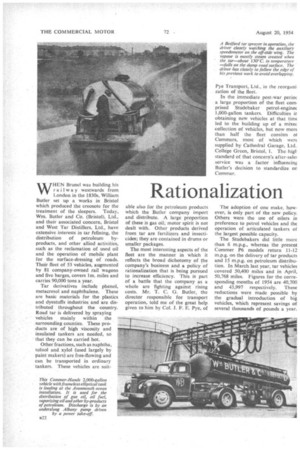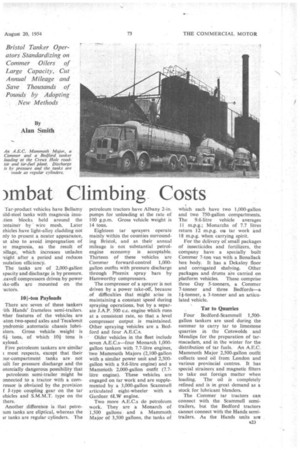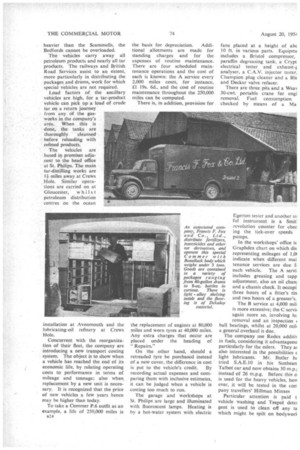Rationalization mabat Climbing Costs
Page 56

Page 57

Page 58

If you've noticed an error in this article please click here to report it so we can fix it.
By
Alan Smith
WHEN Brunel was building his railway westwards from London in the 1830s, William Butler set up a works in Bristol which produced the creosote for the treatment of the sleepers. Today, Wm. Butler and Co. (Bristol), Ltd., and their associated concern, Bristol and West Tar Distillers, Ltd,, have extensive interests in tar fefining, the distribution of petroleum byproducts, and other allied activities, such as the reclamation of used oil and the operation of mobile plant for the surface-dressing of roads. Their fleet of 53 vehicles, augmented by 81 company-owned rail wagons and five barges, covers lm. miles and carries 90,000 tons a year.
Tar derivatives include phenol, rnetacresol and naphthalene. These are basic materials for the plastics and dyestuffs industries and are distributed throughout the country. Road tar is delivered by spraying vehicles mainly within the surrounding counties. These pro ducts are of high viscosity and insulated tankers are needed, so that they can be carried hot. Other fractions, such as naphtha,
toluol and xylol (used largely by paint makers) are free-flowing and can be transported in ordinary tankers. These vehicles are suit
able also for the petroleum products which the Butler company import and distribute. A large proportion of these is gas oil; motor spirit is not dealt with. Other products derived from tar are fertilizers and insecticides; they are contained in drums or smaller packages.
The most interesting aspects of the fleet are the manner in which it reflects the broad dichotomy of the company's business and a policy of rationalization that is being pursued to increase efficiency. This is part of a battle that the company as a whole are fighting against rising costs. Mr. T. C. G. Butler, the director responsible for transport operation, told me of the great help given to him by Col. I. F. E. Pye, of Pye Transport, Ltd., in the reorgani. zation of the fleet.
In the immediate post-war perio( a large proportion of the fleet corn. prised Studebaker petrol-engine( 1,000-gallon tankers. Difficulties ir obtaining new vehicles at that time led to the building up of a rnixec collection of vehicles, but now more than half the fleet consists oi Comrners, most of which were supplied by Cathedral Garage, Ltd. College Green, Bristol, 1. The high standard of that concern's after-sales service was a factor influencing Butler's decision to standardize on Cornmer.
The adoption of one make, however, is only part of the new policy. Others were the use of oilers in preference to petrol vehicles and the operation of articulated tankers of the largest possible capacity.
The Studebakers did little more than 6 m.p.g., whereas the present Commer P6 models return 11-12 m.p.g. on the delivery of tar products and 15 m.p.g. on petroleum distribution. In March last year, tar vehicles covered 50,400 miles and in April, 50,768 miles. Figures for the corresponding months of 1954 are 40,700 and 43,997 respectively. These reductions were made possible by the gradual introduction of big vehicles, which represent savings of several thousands of pounds a year. Tar-product vehicles have Bellamy tild-steel tanks with magnesia insution blocks held around the fltainer by wire mesh. Later chides have light-alloy cladding not nly to present a neater appearance, ut also to avoid impregnation of ie magnesia, as the result of 3illage, which increases unladen 'eight after a period and reduces isulation efficiency.
The tanks are of 2,000-gallon i.pacity and discharge is by pressure. ,eavell compressors driven by power tke-offs are mounted on the .actors.
101-ton Payloads There are seven of these tankers 'ith Hands' frameless semi-trailers. Pater features of the vehicles are aton two-speed axles and Tecalemit yndromic _automatic chassis lubri Itors. Gross vehicle weight • is 6i tons, of which 10itons is ayload.
Five petroleum tankers are similar most respects, except that their mr-compartment tanks are not uilt for pressure discharge and the otentially dangerous possibility that petroleum semi-trailer might be Dnnected to a tractor with a cornressor is obviated by the provision f 1-type coupling gear on the tar ehieles and S.M.M.T. type on the thers.
Another difference is that petromm tanks are eliptical, whereas the tr tanks are regular cylinders. The petroleum tractors have Albany 2-in. pumps for unloading at the rate of 100 g,p.m. Gross vehicle weight is 14 tons.
Eighteen tar sprayers operate mainly within the counties surrounding Bristol, and as their annual mileage is not substantial petrolengine economy is acceptable. Thirteen of these vehicles are Commer forward-control 1,000gallon outfits with pressure discharge through Plicepix spray bars by Harnworthy compressors.
The compressor of a sprayer is not driven by a power take-off, because of difficulties that might arise in maintaining a constant speed during spraying operations, but by a separate I.A.P. 500 c.c. engine which runs at a consistent rate, so that a level compressor output is maintained. Other spraying vehicles are a Bedford and four A.E.C.s.
• Older vehicles in the fleet include seven A.E.C.s—four Monarch 1,000gallon tankers with 7.7-litre engines, 'two Mammoth Majors (2,100-gallon with a similar power unit and 2,500gallon with a 9.6-litre engine) and a 'Mammoth 2,000-gallon outfit (7.7litre engine). These vehicles are engaged on tar work and are supplemented by a 3,000-gallon Scarnmell articulated eight-wheeler with a Gardner 6LW engine.
Two more A.E.C.s do petroleum ,work. They are a Monarch of 1,500 gallons and a Mammoth Major of 3,500 gallons, the tanks of which each have two 1,000-gallon and two 750-gallon compartments. The 9.6-litre vehicle averages 11 m.p.g.; Monarchs of 7.7 litres return 12 m.p.g, osi tar work and 18 m.p.g. when carrying spirit.
For the delivery of small packages of insecticides and fertilizers, the company have a specially built Commer 7-ton van with a BonalIack box body. It has a DekaIoy floor and corrugated shelving. Other packages and drums are carried on platform vehicles. These comprise three Guy 5-tonners, a Commer 7-tonner and three Bedfords—a 11-tonner, a 3-tonner and an articulated vehicle.
Tar to Quarries Four Bedford-Scammell 1,500gallon tankers are used during the summer to carry tar to limestone quarries in the Cotswolds and Mendips for the preparation of tarmacadam, and in the winter for the distribution of tar fuels. An A.E.C. Mammoth Major 2,500-gallon outfit collects used oil from London and various provincial centres. It has special strainers and magnetic filters to take out foreign matter when loading. The oil is completely refined and is in great demand as a stock for lubricant blenders.
The Commer tar tractors can connect with the Scarrnnell semitrailers, but the Bedford tractors cannot connect with the Hands semitrailers. As the Hands units are heavier than the Scammells, the Bedfords cannot be overloaded.
The vehicles carry away all petroleum products and nearly all tar products. The railways and British Road Services assist to an extent, more particularly in distributing the packages and drums, work for which special vehicles are not required.
Load factors of the ancillary vehicles are high, for a tar-product vehicle can pick up a load of crude tar on a return journey from any of the gasworks in the company's area. When this is done, the tanks are thoroughly cleansed before reloading with refined products.
The vehicles are based in premises adjacent to the head office at St. Philips. The main tar-distilling works are 11 miles away at Crews Hole. Similar operations are carried on at Gloucester, whilst petroleum distribution centres on the ocean installation at Avonmouth and the lubricating-oil refinery at Crews Hole.
Concurrent with the reorganization of their fleet, the company are introducing a new transport costing system. The object is to show when a vehicle has reached the end of its economic life, by relating operating costs to performance in terms of mileage and tonnage; also when replacement by a new unit is necessary. It is recognized that the price of new vehicles a few years hence may be higher than today.
To take a Commer P.6 outfit as an example, a life of 250,000 miles is 224 the basis for depreciation. Addi tional allotments are made for standing charges and for the expenses of routine maintenance. There are four scheduled maintenance operations and the cost of each is known: the A service every 2,000 miles costs, for instance, 11 19s. 6d., and the cost of routine maintenance throughout the 250,000 miles can be computed.
There is, in addition, provision for the replacement of engines at 80,000 miles and worn tyres at 40,000 miles. Any extra charges that occur are placed under the heading of "Repairs."
On the other hand, should a retreaded tyre be purchased instead of a new cover, the difference in cost is put to the vehicle's credit. By recording actual expenses and comparing them with inclusive estimates, it can be judged when a vehicle is costing too much to run.
The garage and workshops at St. Philips are large and illuminated with fluorescent lamps. Heating is by a hot-water system with electric fans placed at a height of ab( 10 ft. in various parts. Equipmt includes a Bristol compressor, paraffin degreasing tank, a Crypt electrical tester and exhaust-i analyser, a C.A.V. injector tester, Champion plug cleaner and a Bla and Decker valve refacer.
There are three pits and a Wea‘ 30-cwt. portable crane for engi removal. Fuel consumption checked by means of a Ma Egerton tester and another ut ful instrument is a Smitl revolution counter for chec ing the tick-over speeds pumps.
In the workshops' office is Graphdex chart on which dis representing mileages of 1,04 indicate when different mai tenance services are due fu each vehicle. The A servi.
includes greasing and tapp adjustment, also an oil chant and a chassis check. It occupi three hours of a fitter's tin and two hours of a greaser's. The B service at 4,000 mul. is more extensive; the C servii
again more so, involving ht. removal and an inspection ball bearings, whilst at 20,000 mill a general overhaul is due.
The company use Redex additi in fuels, considering it advantageou particularly for the oilers. They ai also interested in the possibilities (
light lubricants. Mr. Butler ht. tried S.A.E.10 in his Sunbean
Talbot car and now obtains 30 m.p.1 instead of 26 m.p.g. Before this o is used for the heavy vehicles, hoNI ever, it will be tested in the con pany travellers' Hillman Minxes Particular attention is paid t vehicle washing and Teepol detet gent is used to clean off any ta which might be spilt on bodyworl




































































































